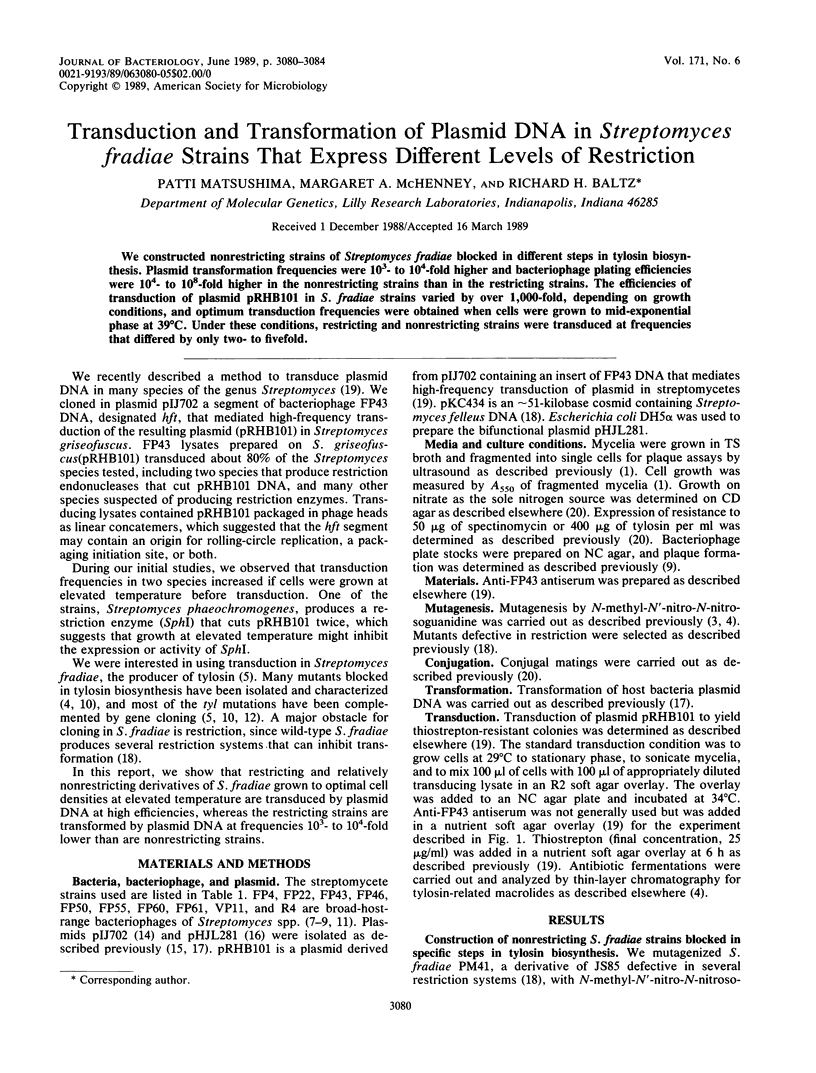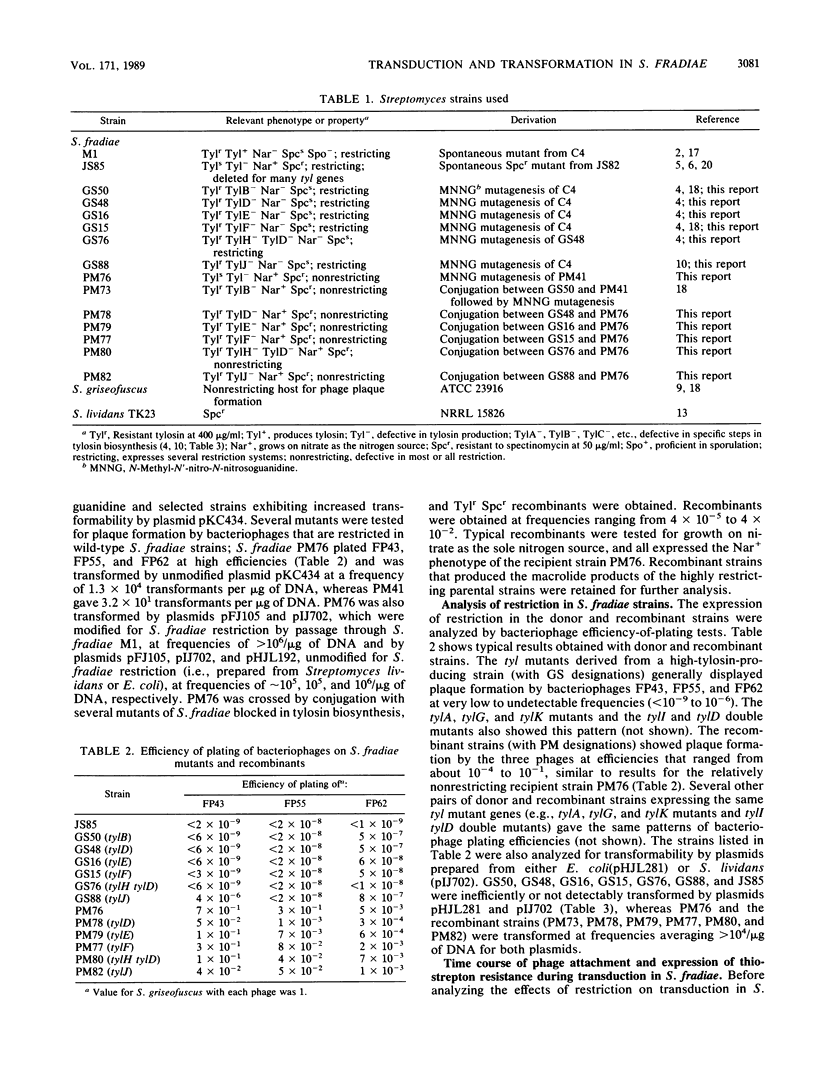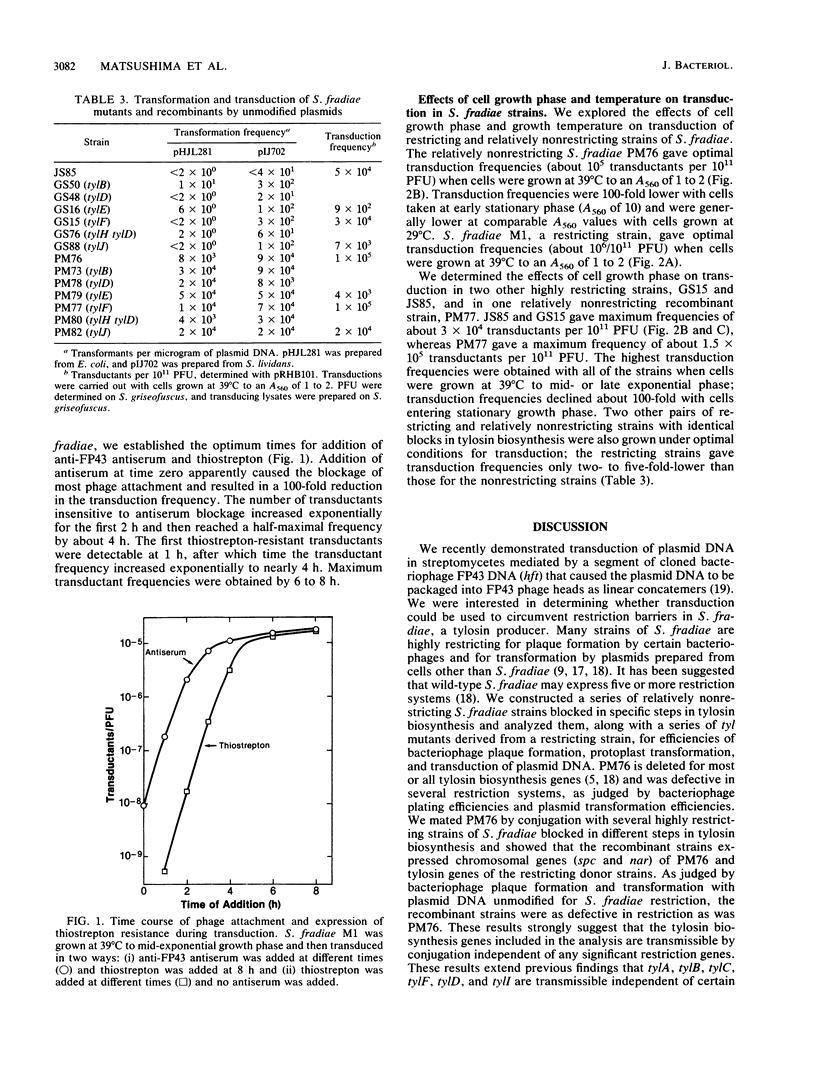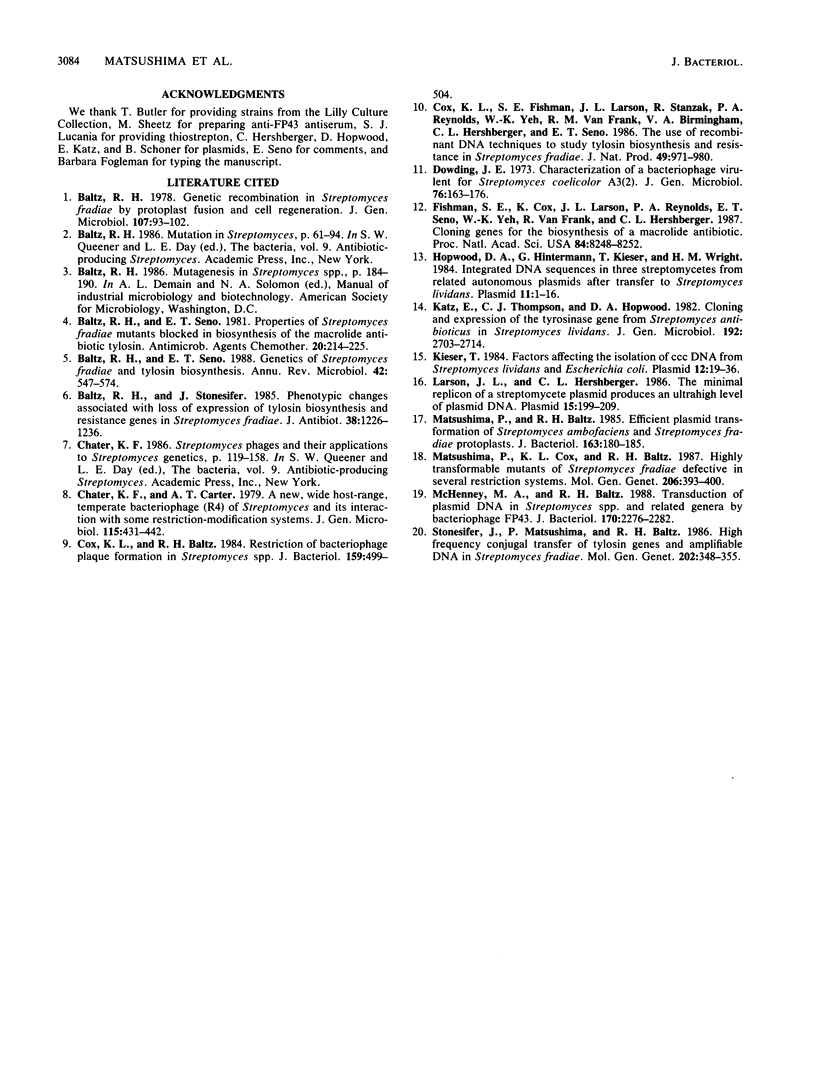Abstract
We constructed nonrestricting strains of Streptomyces fradiae blocked in different steps in tylosin biosynthesis. Plasmid transformation frequencies were 10(3)- to 10(4)-fold higher and bacteriophage plating efficiencies were 10(4)- to 10(8)-fold higher in the nonrestricting strains than in the restricting strains. The efficiencies of transduction of plasmid pRHB101 in S. fradiae strains varied by over 1,000-fold, depending on growth conditions, and optimum transduction frequencies were obtained when cells were grown to mid-exponential phase at 39 degrees C. Under these conditions, restricting and nonrestricting strains were transduced at frequencies that differed by only two- to fivefold.
Full text
PDF




Selected References
These references are in PubMed. This may not be the complete list of references from this article.
- Baltz R. H. Genetic recombination in Streptomyces fradiae by protoplast fusion and cell regeneration. J Gen Microbiol. 1978 Jul;107(1):93–102. doi: 10.1099/00221287-107-1-93. [DOI] [PubMed] [Google Scholar]
- Baltz R. H., Seno E. T. Genetics of Streptomyces fradiae and tylosin biosynthesis. Annu Rev Microbiol. 1988;42:547–574. doi: 10.1146/annurev.mi.42.100188.002555. [DOI] [PubMed] [Google Scholar]
- Baltz R. H., Seno E. T. Properties of Streptomyces fradiae mutants blocked in biosynthesis of the macrolide antibiotic tylosin. Antimicrob Agents Chemother. 1981 Aug;20(2):214–225. doi: 10.1128/aac.20.2.214. [DOI] [PMC free article] [PubMed] [Google Scholar]
- Baltz R. H., Stonesifer J. Phenotypic changes associated with loss of expression of tylosin biosynthesis and resistance genes in Streptomyces fradiae. J Antibiot (Tokyo) 1985 Sep;38(9):1226–1236. doi: 10.7164/antibiotics.38.1226. [DOI] [PubMed] [Google Scholar]
- Cox K. L., Baltz R. H. Restriction of bacteriophage plaque formation in Streptomyces spp. J Bacteriol. 1984 Aug;159(2):499–504. doi: 10.1128/jb.159.2.499-504.1984. [DOI] [PMC free article] [PubMed] [Google Scholar]
- Cox K. L., Fishman S. E., Larson J. L., Stanzak R., Reynolds P. A., Yeh W. K., van Frank R. M., Birmingham V. A., Hershberger C. L., Seno E. T. The use of recombinant DNA techniques to study tylosin biosynthesis and resistance in Streptomyces fradiae. J Nat Prod. 1986 Nov-Dec;49(6):971–980. doi: 10.1021/np50048a002. [DOI] [PubMed] [Google Scholar]
- Dowding J. E. Characterization of a bacteriophage virulent for Streptomyces coelicolor A3(2). J Gen Microbiol. 1973 May;76(1):163–176. doi: 10.1099/00221287-76-1-163. [DOI] [PubMed] [Google Scholar]
- Fishman S. E., Cox K., Larson J. L., Reynolds P. A., Seno E. T., Yeh W. K., Van Frank R., Hershberger C. L. Cloning genes for the biosynthesis of a macrolide antibiotic. Proc Natl Acad Sci U S A. 1987 Dec;84(23):8248–8252. doi: 10.1073/pnas.84.23.8248. [DOI] [PMC free article] [PubMed] [Google Scholar]
- Hopwood D. A., Hintermann G., Kieser T., Wright H. M. Integrated DNA sequences in three streptomycetes form related autonomous plasmids after transfer to Streptomyces lividans. Plasmid. 1984 Jan;11(1):1–16. doi: 10.1016/0147-619x(84)90002-7. [DOI] [PubMed] [Google Scholar]
- Kieser T. Factors affecting the isolation of CCC DNA from Streptomyces lividans and Escherichia coli. Plasmid. 1984 Jul;12(1):19–36. doi: 10.1016/0147-619x(84)90063-5. [DOI] [PubMed] [Google Scholar]
- Larson J. L., Hershberger C. L. The minimal replicon of a streptomycete plasmid produces an ultrahigh level of plasmid DNA. Plasmid. 1986 May;15(3):199–209. doi: 10.1016/0147-619x(86)90038-7. [DOI] [PubMed] [Google Scholar]
- Matsushima P., Baltz R. H. Efficient plasmid transformation of Streptomyces ambofaciens and Streptomyces fradiae protoplasts. J Bacteriol. 1985 Jul;163(1):180–185. doi: 10.1128/jb.163.1.180-185.1985. [DOI] [PMC free article] [PubMed] [Google Scholar]
- Matsushima P., Cox K. L., Baltz R. H. Highly transformable mutants of Streptomyces fradiae defective in several restriction systems. Mol Gen Genet. 1987 Mar;206(3):393–400. doi: 10.1007/BF00428877. [DOI] [PubMed] [Google Scholar]
- McHenney M. A., Baltz R. H. Transduction of plasmid DNA in Streptomyces spp. and related genera by bacteriophage FP43. J Bacteriol. 1988 May;170(5):2276–2282. doi: 10.1128/jb.170.5.2276-2282.1988. [DOI] [PMC free article] [PubMed] [Google Scholar]
- Stonesifer J., Matsushima P., Baltz R. H. High frequency conjugal transfer of tylosin genes and amplifiable DNA in Streptomyces fradiae. Mol Gen Genet. 1986 Mar;202(3):348–355. doi: 10.1007/BF00333261. [DOI] [PubMed] [Google Scholar]


